Pier Hill

Pier Hill Buildings
The
land
lying
between
the
Pier
and
the
Shrubbery
was
utilised
for
a
new
building
in
the
1890s,
up
till
now
little
development
had
been
undertaken,
the
site
consisted
of
a
few
old
wooden
built
huts,
including
a
few
shops,
a
café
and
Ingram’s
hot
baths.
With
increasing
visitors
and
the
construction
of
the
new
iron
Pier
the
Southend
Corporation
Pier
Committee
announced
a
competition
(The
Pier
Hill
Improvement
Scheme
Competition)
companies
were
asked
to
submit
ideas
on
what
should
be
built.
Mr
Thompson
(of
the
firm
of
Thompson
and
Greenhalgh,
a
well
known
firm
of
local
architects)
competed
in
the
competition,
and
his
scheme
was
selected.
The
winning
design
boasted,
Baths,
Promenades,
Shelters,
Arcade,
Bandstand,
Reading
Rooms
and
Clock
Tower
at
a
cost
of
£18,710.
In
1896
the
stone
laying
ceremony
was
performed
by
Mrs
A.
Prevost
and
finally
opened
in
1898.
The
sea
baths
became
famous
throughout
the
country.
Several
of
the
leading
professional
London
football
clubs
sent
their
teams
there
when
preparing
for
their
more
important
cup
matches.
Additions
to
the
sea
baths
and
other
parts
were
provided
later
at
a
cost
of
£12,150.
In
the
1930s
the
Bandstand
with
clock
tower
was
removed
and
moved
to
Chalkwell Park.
Over the years the use of the building changed, it became a tourist information centre and the Pier Foreshore offices, the arcade opened as an aquarium in the 1960s. In the early 1970s the building closed and was demolished in 1977 to make way for the Pier Hill green.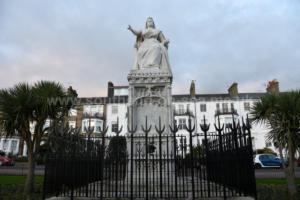
2020 Statue of Queen Victoria Clifftown Parade
Southend Timeline Southend-on-Sea © 2009 - 2024. All Rights Reserved
The
statue
of
Queen
Victoria
was
presented
to
the
town
to
mark
the
Queen’s
Diamond
Jubilee in 1897.
The
Memorial
of
Her
Majesty’s
glorious
Reign
was
a
gift
from
the
Ex-Mayor,
Mr
Bernard
Wilshire
Tolhurst,
which
was
executed
by
J.
M.
Swynnerton
at
his
studios
in
Rome.
The
memorial
statue,
pedestal
and
steps
was
made
of
Carrara
Marble,
the
whole
work
standing
something
over
twenty
feet
in
height.
The
Queen
is
seated
in
a
chair
holding
in
her
left
hand
a
sceptre
and
pointing
with
her
right
over
the
sea.
The
original
position
selected
was
at
the
end
of
the
High
Street
facing
the
mouth
of
the
Thames
so
as
to
command
the
view
of
passing
vessels.
The
pedestal
and
chair
are
Gothic
in
design
-
Tudor
period
-
the
drawings
were made by Mr. Edward Goldie, F.S.B.A.
In
1962
the
statue
was
moved
from
Pier
Hill
to
a
new
location
in
Clifftown
Parade
where
Her
Royal
Highness
is
still
today,
facing
the
Thames
pointing
out
over
the
sea.
On
23rd
August
1974
the
statue
was
put
onto
the
national
listed
buildings
register
by
the
English
Heritage
organisation.
In
1989
the
Council
of
Southend
received
an
offer
from
the
city
of
Victoria
in
British
Columbia,
Canada
to
purchase
and
ship
the
statue
to
a
new
location
outside
their
Provincial
Government
offices
but
the
request
was
rejected.
In
March
2011
there
was
a
proposal
to
move
the
statue
to
the
newly
updated
Victoria
Circus
(Victoria
Gateway), this was also rejected.
Unfortunately
the
statue
has
been
subject
to
vandalism
over
the
years
mostly
with
her
pointing
hand,
her
finger
and
hand
has
been
broken
off
many
times.
In
October
2008
Southend
based
Bedini
&
Sons
sculptures
carved
a
new
hand
from
Carrara
Marble,
only
for
her finger to be broken off again. The statue was professionally cleaned in 2016.
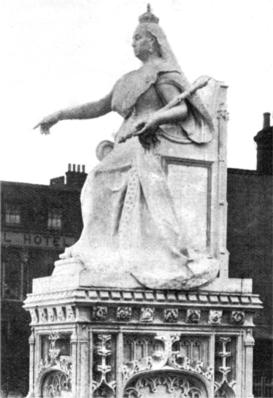
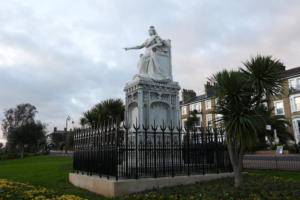
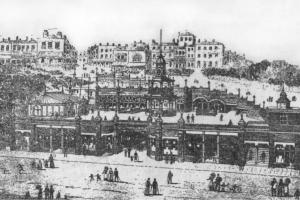
1898 Statue of Queen Victoria Pier Hill
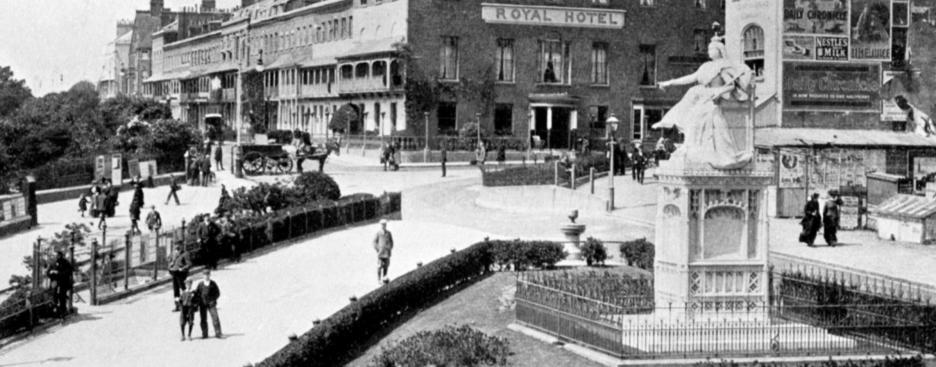
Royal Hotel
In
1791,
under
the
promotion
of
Thomas
Holland,
the
Grand
Terrace,
Grand
Hotel
and
Library
were
built
on
a
prominent
ridge
to
the
west
of
the
‘Old
Town’.
The
scheme
also
included
Assembly
and
Coffee
Rooms.
The
Terrace
and
Hotel
was
completed
in
1793
and
opened
on
the
evening
of
the
8th
July
with
a
ball
attended
by
170
distinguished
guest.
Although
the
resort
soon
began
to
attract
residents
and
visitors
progress
was
slow,
Thomas
Holland,
who
had
the
Hotel
and
nine
of
the
houses
adjacent,
was
carrying
a
heavy
financial
responsibility.
It
was
the
period
of
the
French
wars
when
there
was
constant
fear
of
a
landing
on
these
coast
by
the
enemy.
in
May
and
June
1797
during
the
period
of
mutiny
at
the
Nore
the
Ship
Hotel
was
one
of
the
Headquarters
of
the
leaders
of
the
mutiny.
It
was
recorded
that
no
depredation
whatever
was
committed
at
South
End
by
the
sailors,
but
that
the
town
had
received
few
visitors
during
the
spring
owing
to
the
fear of disturbances.
The
summer
of
1797
Holland
was
unable
to
meet
his
commitments.
A
sale
was
held
of
“all
the
effects
at
the
Hotel,
Tavern,
Assembly
Room,
and
nine
large
dwellings
Houses,
on
the
Terrace,
at
New
South
End,
Late
the
property
of
Thomas
Holland.”
In
June
1800,
the
buildings
and
estate
of
New
South
End
were
sold
by
auction
in
London,
described
as
“
A
Leasehold
Estate
the
sale
consisted
of
the
Capital
Hotel
and
Assembly
Room
with
all
it’s
appurtenances,
and
fifteen
substantial
well
built
convenient
houses,
with
gardens,
enclosed
by
brick
walls,
coach
house
and
stables;
delightfully
situated
on
a
noble
Promenade
(enclosed
with
post
and
chain).
Also
sold
“a
Gothic
Building,
intended
for
a
Public
Library;
a
range
of
coach
houses
in
the
High
Street;
and
eight
houses
in
Market
Street.”
The
bulk
of
the
estate
passed
into
the
possession
of
Mr.
James
Heygate,
whose
son,
Sir
William
Heygate
was
mainly
responsible
for
the
passing
of
the
Southend
Pier
Bill
thirty
years
later,
Other
purchasers
of
houses
on
the
Terrace
were
Sir
T.
M
Wilson,
Bart,
Lady
Langham,
Mr.
J.
T.
Hope,
and
other
families,
some
of
whom
resided
at
South
End
for
the
greater
part of the year.
The
Terrace,
and
the
Hotel
which
was
also
called
the
“Capital”
was
renamed
“Royal”
following
the
visit
to
the
Upper
Town,
of
Princess Caroline. The Royal Terrace and Royal Hotel are still standing and in use today avoiding demolition and the redevelopment.
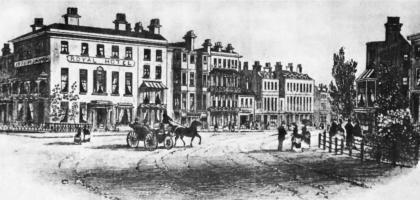
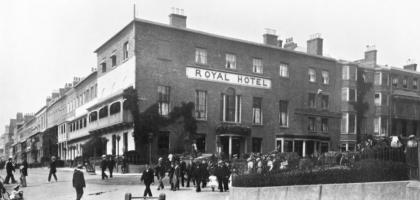
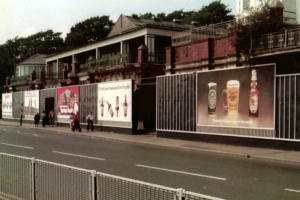
The Statue of Queen Victoria
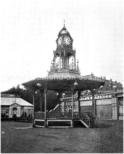
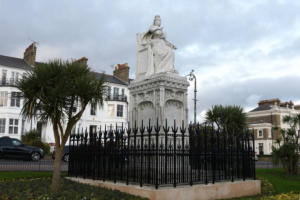
The Shrubbery
The
area
called
“The
Shrubbery”
is
an
piece
of
land
in
front
of
the
Royal
Terrace
which
runs
down
to
Western
Esplanade
west
of
Pier
Hill.
It
was
an
area
of
beauty
and
well
kept
grounds
with
its
entrance
from
the
promenade.
There
was
an
admission
fee
to
enter,
in
1898
the
cost
was
3d,
each
person,
but
weekly
family
tickets
could
be
obtained
for
1s.
This
area
was
later
to
become
the
site
for
Never
Never
Land
which
opened
in
1935,
it’s
most
busiest
period
being
in
the
1950s,
in
1972
it
closed
and
Never
Never
Land
was
removed,
the
area
returned
to
as
it
was
before
but
this
time
it
was
free
to
enter.
In
1987
a
new
look
Never
Never
Land
came
back
to
the
shrubbery
at
a
cost
of
£250,000,
by
2001
dwindling
visitors,
vandalism
and
high
costs
of
running
the
site,
Never
Never
Land
closed
on
Tuesday
16th
January
2001.
In
2019
The
council
installed
the
sleeping
giant,
a
huge
grass
figure
growing
out
of
the
ground
which
is
hoping
to
draw
people
into
the
magic
that
is
the
memory
of
so
many
from
their
childhood
and
will
be
future
memories
for
new
residents
and visitors.
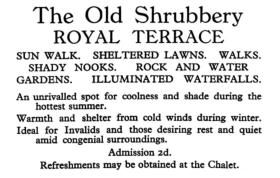
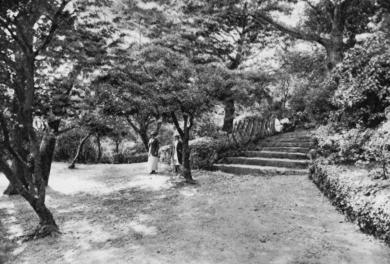
1976 Pier Foreshore Offices
1874 Royal Hotel
c1905 Royal Hotel
1890s New Pier Hill Buildings
Pier Hill Bandstand
Early view in the Shrubbery
Advert Promoting the Shrubbery
Ritz Cinema
Ritz
cinema
was
built
in
1934
-
1935
on
the
corner
of
Grove
Road
and
Church
Road,
at
the
top
of
Pier
Hill,
and
was
owned
by
County
Cinemas,
designed
by
Robert
Cromie
and
built
by
Messrs.
E.
D.
Winn
and
Co.,
of
Knightsbridge.
The
cinema
was
built
in
six
months
by
a
labour
force
of
four
hundred.
The
auditorium
had
a
seating
capacity
of
2,250
and
was
115
feet
long,
85
feet
wide,
the
proscenium
opening
was
50
feet
which
at
the
time
was
the
largest
in
Essex.
This
was
classed
as
a
super
cinema
built
with
modern
air
conditioning,
a
complicated,
but
modern
electric
system,
a
large
Conacher
organ
with phantom piano, latest projectors with wide range sound apparatus.
The
Ritz
opened
on
Thursday
14th
February
1935
by
the
Mayor,
Councillor
A.
T.
Edwards,
in
the
presents
of
a
large
gathering
of
representatives
of
all
branches
of
activity
in
the
life of the Borough.
County
Cinemas
were
merged
into
Oscar
Deutch’s
Odeon
circuit
in
1939,
which
was
taken
over
by
J.
Arthur
Rank
in
June
1940,
on
the
early
tragic
demise
of
Oscar
Deutch.
The
Ritz
closed
September
1940
because
of
wartime
conditions
and
did
not
reopen
until
May
1942,
a
full
schedule
did
not
start
until
26
July
1945
with
the
Saturday
morning
Boys
and
Girls Club.
In
1956
the
Ritz
underwent
refurbishment
and
geared
up
to
become
the
replacement
picture
house
for
the
Gaumont
which
had
closed
that
same
year.
Many
of
the
staff
from
the
Gaumont transferred to the Ritz.
Later
the
café
at
the
Ritz
became
a
ballroom,
then
subsequently
became
disused.
The
organ
was
removed
and
went
to
the
Odeon,
Blackpool.
In
1968,
the
building
received
a
further
facelift,
costing
£6,000.
Sadly
on
8th
March
1972
the
Ritz
as
a
cinema
closed.
The
Ritz
had
been
steadily
losing
money
since
the
twin
Odeon
cinemas
opened.
Next,
at
a
cost
of
£100,000
the
Ritz
was
converted
into
the
Top
Rank
Bingo
Club,
later
being
leased
to
Invictor
Bingo.
In
1978
the
building
closed
and
became
derelict.
Finally,
amid
a
great
outcry
from
conservationists,
theatre
and
film
enthusiast,
The
Ritz
was
demolished
in
January
1981.
The
car
park
of
the
Royals
Shopping
Centre
now
stands
on the site of the Ritz.
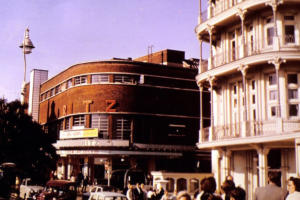
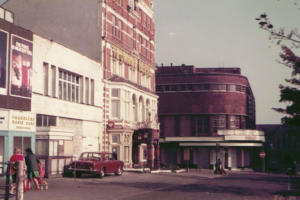

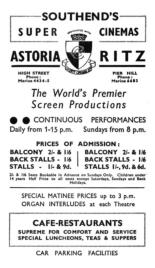
Hotel Metropole
This
landmark
large
hotel
opened
in
1904,
shortly
afterwards
it
was
renamed
the
Palace
Hotel.
The
hotel
was
advertised
as
the
only
5-star
hotel
on
the
South
East
coast.
The
hotel
offered
200
bedrooms,
Private
suites,
Hot
and
cold
running
water,
Central
heating
and
gas
fires,
Sun
lounge,
Palm
court,
2
Masonic
rooms,
Suites
for
official
and
wedding
receptions,
banquets
etc.,
Squash
courts,
Cocktail
bar,
Winter
garden,
Ballroom,
and
billiards
etc.,
this
was
indeed
comfortable
accommodation
for
the
visitors
to
Southend.
In
1929
the
Palace
Hotel
was
offered
to
the
council
to
solve
the
town
hall
problem
which
had
been
going
on
for
nearly
half
a
century,
but
the
council
said
no.
The
cost
was
only
£125,000
which
was
less
than
2s.
rate
and
deductions
of
property
vacated
reduced
the
cost
to
£103,800.
After
many
debates,
the
council
finally
decided
on
Victoria
Avenue.
The
hotel
served
as
a
military
hospital
in
both
world
wars.
The
comedy
duo
Laurel
and
Hardy
stayed
here
in
1952
whilst
appearing
in
a
variety
show
at
the
Odeon
in
the
High
Street.
In
the
latter
years
the
building
began
to
look
tired
and
uncared-for
until
a
full
refurbishment took place and the new Park Inn Palace Hotel opened on 1st March 2010.
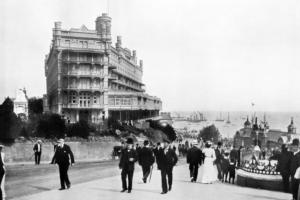
1961 The Ritz
1971 The Ritz
1977 The Ritz
c1905 Hotel Metropole
1939 Advert for the Ritz
Early view of the Shrubbery
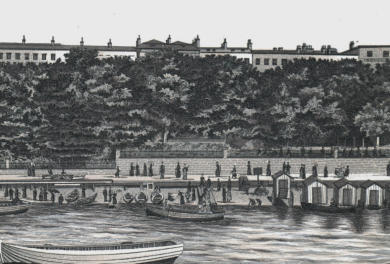
The Lion Hotel
The
Lion
Hotel
was
built
b1840,
In
1863
John
Chignell
is
listed
as
the
proprietor.
The
Pier
Hotel
opened
on
this
site
sometime
around
the
‘Lion’
closing
and
it
being
demolished.
In
about
1898
a
portion
of
the
Pier
Hotel
was
rebuilt,
it
was
advertised
at
the
time
as,
‘The
Hotel
which
has
been
rebuilt
is
situated
five
minutes’
walk
from
the
London
Tilbury
and
Southend
Railway,
and
about
ten
minutes
from
the
Great
Eastern.
The
Royal
Stables
are
at
the
rear
of
the
Hotel,
and
conveyances
of
every
description
can
be
obtained
from
the
Proprietor
at
a
few
moment’s
notice;
in
fact,
nothing
need
be
wanted
to
make
to
make
life
on
your
holidays
happy.
The
management
seem
to
anticipate
your
every
wish,
and
strive
their
utmost
to
make
you
feel
that
you
are
at
home
away
from
home.’
The Proprietor was H. Choppin.
Later
further
improvements
took
place
under
the
ownership
of
Messrs.
Truman,
Hanbury,
Buxton
and
Co.,
Ltd.,
and
opened
as
the
Grand
Pier
Hotel
under
the
proprietorship
of
Mr.
Steve
Slinger,
the
main
building
contractors
were
Messers.
Jas
Flaxman and Sons Ltd., 114 Southchurch Road, Southend-on-Sea.
Mr.
and
Mrs.
Steve
Slinger
were
both
well
known,
for
five
years
he
had
been
the
host
of
the
Spread
Eagle
Hotel,
Witham,
previously
residing
in
Chelmsford,
where
they
were
prominently
identified
with
the
entertainment
of
the
public.
At
the
Empire
Theatre
there
variety
shows
were
on
par
with
the
best
London
entertainments.
Mr
and
Mrs
Slinger were also associated for some time with the control of the Select Kinema.
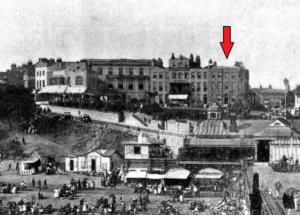
Pier Hill with the Lion Hotel arrowed
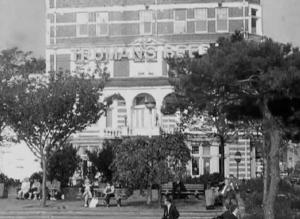
1977 Grand Pier Hotel
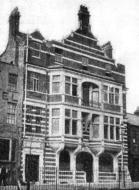
The Pier Hotel
Pier Restaurant
The
Pier
Restaurant
(previously
Chignells
owned
by
William
Joseph
Chignell
who
was
a
linen
Draper)
was
next
door
to
the
Lion
Hotel/Pier
Hotel.
The
proprietor
in
the
1890s
was
Mr.
A.
W.
Bates.
Noted
fish
suppers
served
every
evening
7
to
11.
Hot
dinners
from
12:30
to
3pm
cut
from
the
joint
with
2
vegetables,
from
1/-.
Teas,
cup
of
good
tea.
Coffee
or
Cocoa
2d.
Plain
Tea
6d,
with
shrimps
and watercress 9d, or with Ham, egg, or cold meat 1s.
Beanfeasts
and
small
parties
catered
for,
accommodation
for
cyclist.
The
Pier
Restaurant
closed
and
did
not
relocate
when
this
building was demolished.
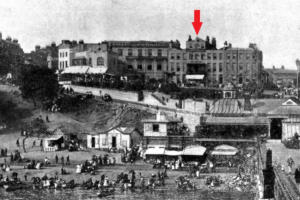
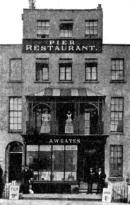
Southend Picture Palace
The
Southend
Picture
Palace
owned
by
Mr.
R.
Arnold
was
built
next
door
to
the
Grand
Pier Hotel and opened in June 1909.
by
1913
ownership
had
changed
to
Mr
F.
F.
Ramuz
who
also
owned
the
Gem
Electric
Theatre,
Victoria
Avenue,
the
name
was
also
changed
to
the
Grove
Picture
Theatre.
In
1914,
the
name
changed
again
to
the
Pier
Hill
Cinema,
Mr
Burgh
was
now
the
new
owner having purchased the cinema from Mr Goldberg.
The
building
had
a
short
life
as
a
bioscope,
closing
in
1919.
For
a
time
after
it
was
used
as
a
Billiards
Hall,
later
being
developed
into
part
of
a
coach
station,
the
building
next
door
the
other
part,
and
used
by
Westcliff
Motor
Services.
In
1981
the
site
of
the
former
cinema was demolished for the Royals Shopping Centre.
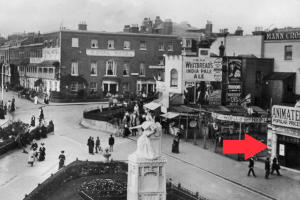
Pier Hill with the Pier Restaurant arrowed
Pier Hill with the cinema arrowed
Pier Restaurant
The
promoters
of
the
scheme
to
develop
a
fashionable
sea
bathing
centre
on
the
Essex
Coast
had
in
mind
the
attractions
that
Brighton
and
Margate
could
offer,
no
attempt
was
made
to
re-fashion
the
village
(Old
or
Lower
Town),
which
had
already
won
some
small
repute
as
a
place
for
sea
bathing.
Instead
of
building
or
rebuilding
in
the
old
town
of
South
End,
what
would
be
created
was
a
new
town
or
New
South
End
(Upper
Town).
The
area
for
development
would
be
its
western
edge
on
the
higher
land
above
the
cliffs,
on
what
had
been
a
barren
plain,
or
woodland
waste.
The
site
was
covered
by
a
grove
consisting
mostly
of
ash
trees,
which
extended
along
the
Cliffs
to
the
top
of
what
later
became
Pier
Hill.
This
would
be
a
prominent
position
for
buildings,
a
great
advert
for
the
resort
to
those
who
passed
up
and
down
the
Thames,
with
extensive
views
over
the
Estuary,
with
tree
covered
Cliff
paths
leading
down
to
the
bathing
place.
By
the
year
1791
progress
had
been
made
in
the
building
of
the
Terrace
(Royal
Terrace)
and
the
Grand
Hotel (Royal Hotel) by Thomas Holland.
Mr
John
Thomas
Hope,
who
owned
a
house
on
the
Royal
Terrace.
He
had
known
Southend
since
1791
and
could
speak
of
the
condition
of
Pier
Hill
from
many
years‘
knowledge.
The
road
leading
from
The
Royal
Hotel
to
the
lower
part
of
Southend,
he
said,
was
formerly
nothing
more
than
a
transverse
line
down
a
slope
of
the
cliff.
It
was
then
very
steep
and
not
more
than
breadth
enough
for
a
single
cart.
There
was
a
gate
in
the
middle
of
the
road
and
the
land
on
each
side
had
fallen
away
so
much
that
there
was
only
room
for
the
single
vehicle.
The
road
went
from
the
beach
up
to
the
top
of
the
Cliff
was,
Mr.
Hope
believed,
to
be
Major
Scratton’s
private
property
and
nobody
else
had
a
right
to
it.
A
footpath,
however,
formerly
went
along
it
the
whole
way.
Major
Scratton,
he
said
covenanted
by
his
lease
to
grant
to
the
lessees
up
above
a
right
of
way
down
the
hill.
They
contended
that
the
Major
was
bound
to
find
not
only
a
road,
but
a
good
road.
The
work
was
done
by
himself
or
the
shopkeepers.
The
trouble
arose
from
the
nature
of
the
soil.
The
clay
was
of
a
brittle
nature
and
when
exposed
to
the
atmosphere
it
crumbled.
They
often
wanted
Major
Scratton
to
use
his
influence
with
the
parish
to
get
them
to
take
it
over
as
a
public
road,
but
he
would
not
do
so.
Before
the
road
was
made
there
was
only
one means of communication, a road down to the seashore that was Mr Vandervord’s house up to Prittlewell (Old Southend Road).
Prospect House
Prospect
House
situated
at
the
top
of
Pier
Hill
opposite
the
Royal
Hotel
was
the
home
of
William
Warwick
who
had
been
the
Doctor
in
residence
since
the
1840s.
George
Deeping
a
physician
who
had
begun
his
medical
career
at
Guys
Hospital
met
and
married
one
of
Warwick’s
daughters,
he
then
joined
her
father’s
practice.
In
1877
their
first
child
George
Warwick
Deeping
was
born
at
Prospect
House,
he
later
became
a
famous
writer.
The
building
would
later
become
Goings,
a
popular
fishing
tackle
shop.
Prospect
House
was
demolished
for
the
Royals
Shopping
centre.
The
underpass
constructed
in
Southend
in
the
late
1960s
early
1970s
was
named
“The
Deeping”
after
George Warwick Deeping.
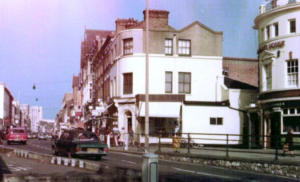
Royal Library
The
Royal
Library
situated
opposite
the
Royal
Hotel
was
a
part
of
the
new
Southend,
it
had
good
reading
rooms
and
was
popular
especially
in
the
evenings
owing
to
the
raffles
and
other
similar
amusements.
In
1890
Charles
and
Zillah
Bullock
took
over,
Charles
began
to
sell
stationary
and
cigars
as
well
as
providing
newspapers.
In
1901
a
Receiving
Order
was
made
against
Zillah
Bullock.
In
1913
the
Royal
Library
with
joining
land
was
sold
at
auction
to
Frederick
Ramuz
for
£4,000.
Later
the
building
would
be
utilised
for
different business adventures until it was demolished for the Royals Shopping Centre.
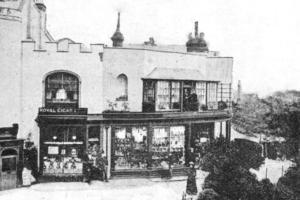
Royal Stores
The
Royal
Stores
(Rod
and
Reel)
was
situated
at
the
top
of
Pier
Hill.
Consisting
of
a
Tavern,
restaurant
with
seating
for
200
people,
smoking
room
and
billiards
hall.
The
Royal
Stores
had
a
long
colourful
life
serving
visitors
and
locals.
The
building
was
demolished to make way for the Royals Shopping Centre.
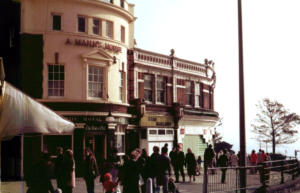
Pier Hill Fairground
c1889
a
fairground
had
been
established
on
Pier
Hill.
The
fairground
lasted
until
the
building
of
the
Hotel
Metropole
in
c1900.
The
‘Roly-Poly’
ride
secured
all
joys
of
complete seasickness, without leaving dry land.
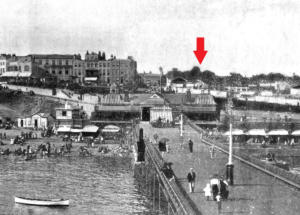
1977 Royal Stores
Pier Hill with the fairground arrowed
1977 Prospect House
1897 Royal Library
Working at the Grand Pier Hotel 1949
Today’s
generation
of
Southenders
will
be
unfamiliar
with
the
Grand
Pier
Hotel
that
once
stood
proud
on
top
of
Pier
Hill.
It
was
a
tall
building,
set
back
from
the
Palace
Hotel,
next
door
to
the
Eastern
National
coach
company,
just
across
the
road
from
the
Ritz
Cinema.
For
guests
staying
there
they
really
did
have
everything
at
hand.
Splendid
sea
views
along
with
the
convenience
of
being
very
close
to
the
town
centre
and
all
its
amenities.
Today
of
course
this
view
is
very
different,
save
for
the
Royal
Hotel
to
the
far
left
and
the Palace Hotel peeking in from the right, the whole centre section is now taken up with the Royal's Shopping Centre.
Brian
Mendes
from
Kitchener,
Ontario,
Canada,
contacted
Southend
Timeline
and
mentioned
he
once
worked
at
the
Grand
Pier
Hotel;
never
to
miss
an
opportunity
Southend
Timeline
asked
him
a
few
questions,
and
considering
the
time
that
has
passed
Brian
has done a splendid job in recalling his days in Southend, enjoy....
Southend
Timeline
Brian
thank
you
for
taking
time
to
provide
Southend
Timeline
an
inside
glimpse
into
the
Grand
Pier
Hotel,
when exactly did you work at the Grand Pier Hotel?
Brian
I
worked
there
as
a
temporary
hall
porter
from
sometime
in
July
1949
until
about
mid
December
1949.
I
was
living
with
my
father
and
his
second
wife
in
a
bungalow
on
Chalkwell
Avenue
having
sat
the
Higher
School
Certificate
exam
before
leaving
Dunstable
Grammar
School
in
June
1949.
I
had
applied
for
University
entrance
but
my
acceptance
was
dependent
upon
my
gaining
a
State
or
County
Scholarship.
I
knew
that
if
I
did
not
get
into
University
I
would
have
to
complete
my
National
Service
starting
soon
after my eighteenth birthday which was in September 1949.
So
I
went
looking
for
a
job
to
earn
some
money
regardless
of
whether
or
not
I
went
to
University.
My
exam
marks
were
not
good
enough
for
a
State
Scholarship
or
a
County
Major.
Every
eighteen
year
old
male
knew
the
process
following
registration
for
National
Service,
which
for
me
was
knowing
the
fact
that
I
would
be
called
up
very
early
in
1950.
Without
deferment
there
was
no
point
in
seeking
a
job
with
career
prospects,
knowing
that
no
employer
would
take
on
a
fellow
who
would
be
called
up
for
National
Service
only
a
few
months
after
being
hired.
So
the
job
as
a
temporary
hall
porter
at
Mickey
Wilson's
Grand
Pier
Hotel
in
Southend
was
my
occupation upon leaving school.
Southend Timeline
What was your role in the hotel. Can you describe your duties?
Brian
I
was
at
the
beck
and
call
of
the
Hotel
Manager,
his
wife,
the
permanent
hall
porter
and
the
hotel
guests...a
general
factotum,
so
to
speak.
I
usually
worked
the
day
shift
but
came
in
late
afternoons
when
asked
to.
My
fixed
duties
were
to
clean
the
men’s
wash-
room
on
the
first
floor,
polish
the
brass
plates
where
ever
they
were,
tidy
up
the
small
lounge
bar
which
was
separate
from
the
large
Public,
Saloon
and
Lounge
bars
which
were
on
the
ground
floor.
I
met
guests
at
the
separate
hotel
entrance,
carried
their
luggage
to
and
from
their
rooms.
I
suspect
that
the
regular
porter,
made
sure
he
attended
to
the
regulars
who
were
good
tippers.
I
did
take
ordered
drinks
to
guests
in
their
rooms
The
most
unpleasant
job
was
assisting
the
old
fellow
who
washed
the
dishes
in
a
tiny
scullery.
This
was
not
a
regular
assignment.
Much
of
the
shift
was
spent
listening
to
the
stories
from
Jimmy
the
regular
hall
porter
and
the
waitresses who waited tables in the restaurant.
Southend
Timeline
Can
you
describe
the
hotel,
what
it
was
like
inside,
did
it
have
any
function
rooms,
restaurants
or
bars.
What
standard of hotel was it?
Brian
The
Grand
Pier
was
generally
regarded
as
one
of
the
better
hotels
in
Southend.
I
recall
it
having
both
AA
and
RAC
approval.
Downstairs
was
separate
from
the
hotel
and
restaurant,
and
had
a
manager
and
staff
for
the
three
bars.
It
was
a
Truman
House
as
you
can
see
from
the
photo.
There
were
very
few
free
houses
in
those
days.
The
hotel
manager
and
his
wife
(who
I
worked
for
)
had
London
hotel
experience
as
had
the
regular
hall
porter.
The
chef
was
quite
a
character
who
lusted
after
one
of
the
waitresses,
an
attractive
30
something
redhead..Marge
was
her
name,
I
believe.
I
do
not
recall
any
large
reception
rooms
but
suspect
that
in
the
later
years
the
large
restaurant
area
may
have
been
used
for
functions.
The
focal
point
of
the
first
floor
hotel
area
was
the
small
lounge
bar
that
had
its
own
select
patrons.
I
doubt
that
most
downstairs
patrons
even
knew
of
its
existence.
I
saw
the
lunchtime
regulars..mostly
nouveau
rich
businessmen,
often
accompanied
by
their
lady
friends.
One
was
a
neighbour
of
ours
who
lived
next
door
on
Chalkwell
Ave...he
never
realised
who
I
was!!
Several
of
the
patrons
of
this
bar
were
lushes
to
the
n'th
degree
and
had
to
escorted
to
a
taxi
well
after
closing
time.
The
hotel
manager
knew
his
stuff
and
gave
fawning
attention
to
those
who
dropped
big
money
in
the
bar.
I
am
pretty
certain
that
the
Grand
Pier
was
commandeered
during
the
war
and
was
one
of
the
places
where
convoy
control
was
organised.
There
was
a
naval
theme
mural
on
one
of
the
walls
of
the
upstairs
bar
and
it
was
said
to
have
been
painted
by
one of the naval personnel from the wartime operations.
The
owner,
Mickey
Wilson
had
good
connections
with
the
county
cricket
crowd
and
the
Essex
team(or
opponents)
stayed
at
the
hotel
during
Festival
Week
at
Southchurch
Park.
The
Regal
Music
Hall
Theatre
was
still
open
and
several
of
the
performers
stayed
when
they
hit
town.
I
remember
only
one...
Max
Wall
the
comedian,
because
I
had
to
fetch
something
from
his
room
when
he
was
not
there
and was surprised to see a large book on his table, the World's Best Jokes.
Southend Timeline
Can you remember at the time what a young guy would do with his spare time in Southend?
Brian
I
was
not
typical
because
from
1940
to
1949
I
was
away
at
boarding
school
and
only
home
for
the
holidays.
We
lived
in
the
town
from
1935
to
1940
when
I
and
my
brother
were
evacuated.
My
parents
moved
to
Richmond
,Surrey
but
returned
to
Westcliff
in
the
summer
of
1943,
once
the
travel
restrictions
were
lifted.
Home
then
was
98
Chalkwell
Ave
and
I
used
the
No
17
bus
to
get
to
and
from
work.
Once
I
left
school
in
1949,
I
joined
the
Southend
Rugby
club
and
the
few
friends
that
I
had
were
club
members.
My
mother
ran
a
ballroom
dancing
school
just
off
Hamlet
Court
Road
and
I
learned
enough
to
go
to
dances.
Val
West
(who
now
lives
in
Toronto)
and
I
used
to
try
our
luck
at
the
Kursaal
Ballroom
where
Howard
Baker's
Band
was
in
residence.
I
lost
touch
with
all
my
pre-war
school
friends
and
none
of
my
Dunstable
chums
lived
in
Southend.
In
fact
I
was
very
glad
to
go
into
the
army
when
called
for
National Service.
I
was
saddened
to
learn
many
years
after
the
fact
that
the
Grand
Pier
Hotel
had
been
torn
down
to
make
room
for
a
shopping
centre.
I
have
been
an
infrequent
visitor
to
the
UK
since
emigrating
to
Canada,
and
it
is
only
since
acquiring
a
PC
that
I
have
tried
to
follow
events
in
the
town
.I
did
purchase
a
copy
of
The
Southend
Story...
A
town
and
its
People,
compiled
by
Tom
King
and
Kevan
Furbank
and learned more about the town than I ever knew when I lived there.
The Grand Pier Hotel was demolished in the early 1980s to make way for the new Royals Shopping Centre development.
2007 Pier Hill Fountain Working
The Fountain
Another
attraction
that
was
part
of
the
redeveloped
Pier
Hill
was
a
fountain
that
was
located
opposite
to
the
entrance
of
the
Pier.
The
fountain
featured
dancing
spouts
of
water
that
would
alter
in
timing
and
height,
children
would
play
chicken
as
they
darted
through
the
resting
spouts
in
the
hope
that
they
would
not
get
a
sudden
soaking!
However,
drainage
issues
saw
water
seeping
into
the
buildings
below
resulting
the
the
taps
being
turned
off
until
a
solution
could
be
found,
the
problem
persisted
so
the
fountain
was
removed.
Pier Arcade and the Construction of Pier Hill Green
Over
the
years
the
use
of
the
Pier
Arcade
would
change
regularly,
the
Southend
Corporation
used
the
building
for
its
Tourist
Information
Centre
and
Pier
&
Foreshore
Offices,
an
aquarium
was
also
opened
in
the
arcade
during
the
mid
1960s.
However,
the
structure
was
becoming
more
difficult
to
maintain
and
the
old
problem
of
the
stability
and
natural
spring
water
courses
running
throughout
the
cliffs
caused
many
problems,
these
eventually
caused the closure of the buildings in the early 1970s.
The
site
was
demolished
in
1977
and
landscaped
to
form
the
Pier
Hill
green.
Evidence
of
the
sites
previous
use
was
evident
as
the
top
of
the
arched
shop
fronts
could
still
be
seen
just
poking
above
the
hill.
Also
still
present
was
the
two
windows
that
looked
into
the
swimming
baths,
these
were
found
on
the
steps
that
run
up
the
side
of
Jenny’s
Café,
they
had
been
bricked
and
concreted
over
when
the
rest
of
the
buildings
were
demolished
but
the
recesses
had survived.
Lifelines
Another
aspect
of
the
redevelopment
of
Pier
Hill
was
the
installation
of
a
piece
of
public
art.
In
2006
Southend
Borough
Council
were
awarded
£390,000
by
the
Arts
Council
to
install
a
new
public
art
installation
on
the
newly
redeveloped
Pier
Hill.
The
new
art
work
that
was
commissioned
was
to
be
a
“living”
piece
designed
by
Vong
Phaophanit
and
Claire
Oboussier
and
named
“Lifelines.”
The
new
installation
was
a
54-metre-long sculpture with a width of 0.5meters.
The
artwork
featured
six
lines
of
coloured
panels
in
the
walkway
leading
to
a
large
clear
acrylic
box
structure
the
coloured
panels
in
the
walkway
then
continued
on
the
other
side
box.
The
large
clear
acrylic
box
structure
measured
9m
long
x
0.5m
wide
with
a
height
of
2m.
Inside
the
box
of
the
artwork,
were
6
individual
1.8M
high
polycarbonate
sheets.
Each
of
these
was
etched
with
an
“ECG”
style
"heartbeat"
along
its
length,
which
was
illuminated by the LED channels underneath the box.
The
name
“Lifelines”
came
from
the
fact
that
as
well
as
the
light
box
a
weather
monitoring
station
was
erected
at
the
top
of
Pier
Hill.
This
would
collect
data
on
wind
speed,
barometric
pressure,
humidity,
light,
sound
and
movement,
and
fed
to
a
data
logger
which
processed
the
information
via
an
on-site
computer,
from
there
signals
were
sent
to
pulsate
and
change
the
colours
of
each
life
line.
There
was
in
excess
of
100,000
LED's
and
1024
DMX
addresses
to
produce
this
light
feature.
Lifelines
worked
well
in
the
first
few
years
of
it's
life,
but
it
was
targeted
by
vandals
who
would
scratch
their
names
into
the
acrylic
panels,
condensation
also
became
a
problem
as
air
could
not
pass
freely
inside
the
box,
these
issues
soon
led
to
it
breaking
down.
With
the
continued
problems
in
maintaining
and
keeping
the
artwork
going,
the
council
voted
to
remove
and
place
Lifelines
into
storage at the cost of £20,000. Lifelines was finally removed in March 2011.
A tiled wall still in good condition
The small flat area that was the spot the statue of
Queen Victoria
The red phone boxes that once stood at the very top of
Pier Hill and the shelter
2006 Lifelines
Photographed on a snowy February day in 2012
Two views of Lifelines in March 2011, just days before it was removed
2012 A Hidden Piece of History...
Despite
the
rebuilding
of
Pier
Hill
one
small
part
of
the
old
hill
survives.
A
shelter
under
the
upper
level
was
provided
half
way
up
Pier Hill with a row of seats inside, remarkably the shelter and the seats survived behind the locked gate and a stone wall.
Lifelines today... its gone!
Pier Hill Demolition
The
site
was
to
remain
this
way
until
the
complete
renovation
of
Pier
Hill,
this
saw
the
last
remaining
elements
of
the
Pier
Arcade
finally
being
demolished.
During
the
excavation
parts
of
the
pier
arcade
buildings
were
found
including
a
tiled
wall,
and
various
other
small
parts
of
demolition
rubble.
These
next
few
photos
take
a
look
at
the
demolition
of
the
1977
Pier
Hill,
remnants
discovered
of the 1898 Pier Hill.
Two views of Pier Hill the curved wall at the top is the remains of the grand staircase whilst the arches are remains of the shops
What were windows were also discovered during the
works
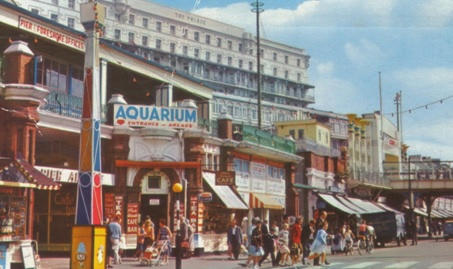
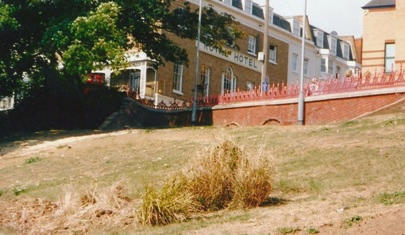
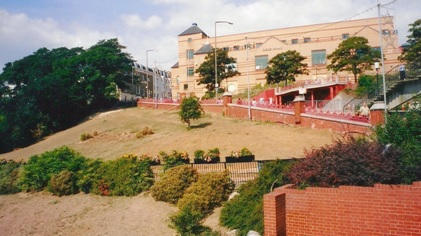
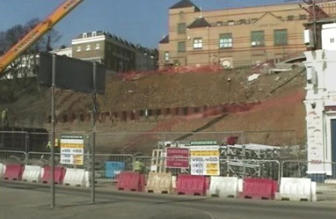
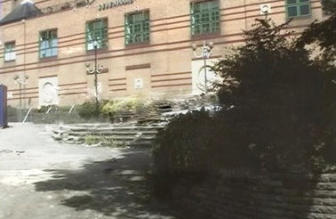
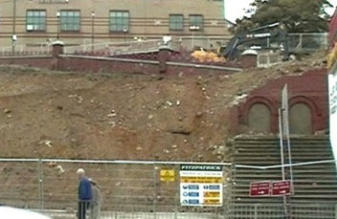
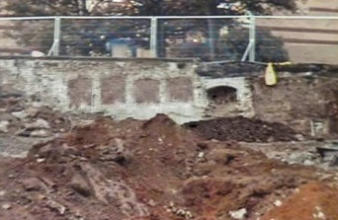
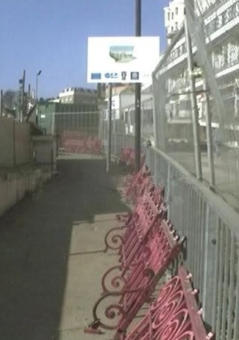
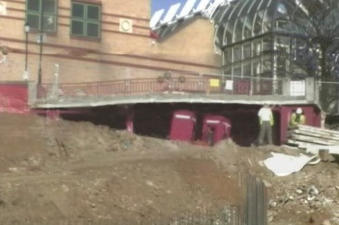
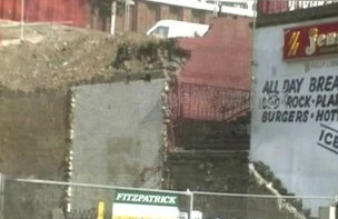
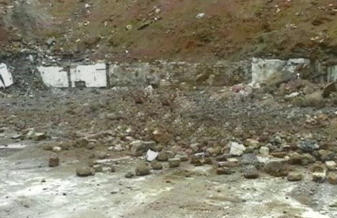
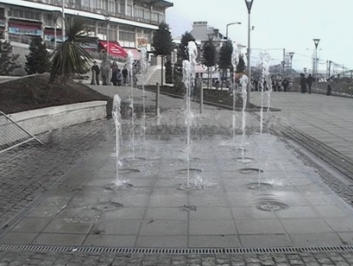
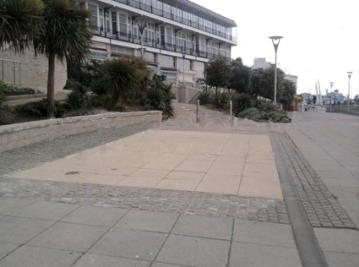
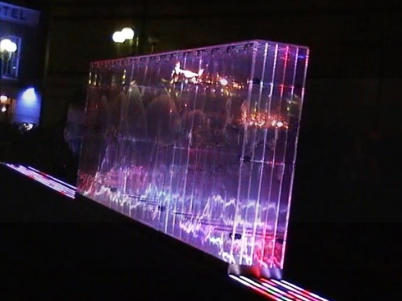
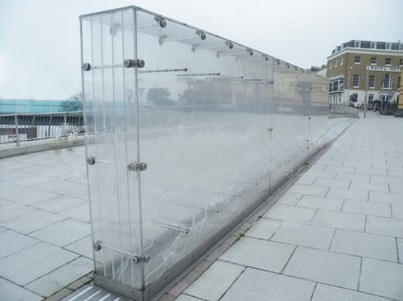
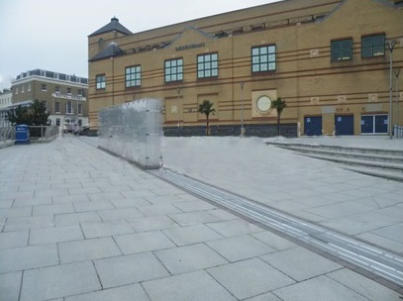
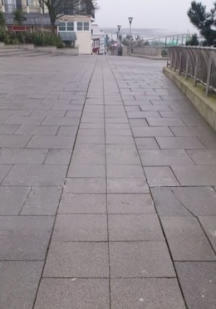
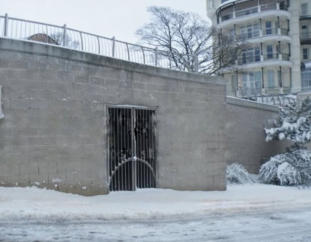
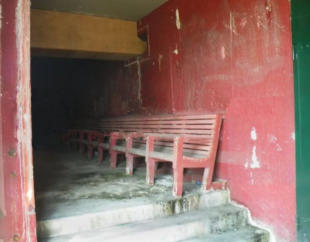
Pier Arcade
2011 Pier Hill Fountain after its removal
The New Pier Hill
The
redevelopment
of
Pier
Hill
saw
winding
pathways,
more
staircases
added
along
the
length
of
the
hill,
and
sloped
landscaping.
Something
the
old
Pier
Hill
had
lacked
was
seating,
the
redevelopment
saw
dozens
of
extra
seats
installed
along
with
flowerbeds
and
trees. The historic Grand Staircase that was built in 1898 was also rebuilt in the same position.
The
cost
of
rebuilding
Pier
Hill
cost
£5.8m,
the
money
came
from
two
grants
one
from
the
Office
of
the
Deputy
Prime
Minister
(£3.7m),
with
the
second
coming
from
the
European
Union
Objective
2
scheme.
Pier
Hill
was
formally
opened
on
19th
January
2005
by
Keith
Hill
MP,
Minister
for
the
Thames
Gateway.
The
design
of
Pier
Hill
was
to
develop
an
open
gateway
between
the
Seafront
&
the Pier with the High Street.
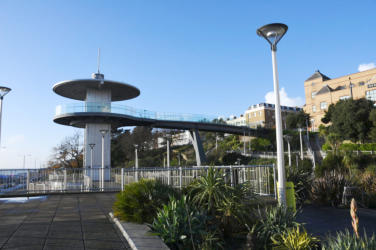
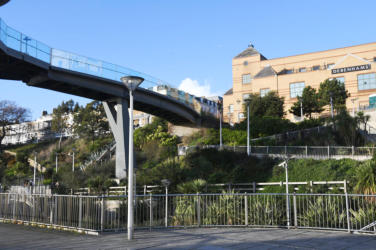
2020 Pier Hill The popular viewing tower forms a striking feature on the seafront. Two lifts are provided to access the upper lever of
Pier Hill leading to the High Street
Corporation Inquiry Bureau
(Tourist Information)
The
Bureau
was
opened
on
the
14th
June
1928,
and
was
located
in
a
commanding
position
at
the
top
of
Pier
Hill,
facing
the
High
Street.
The
Bureau
was
open
on
weekdays
throughout
the
year,
on
Sundays
from
Whitsun
to
the
early
part
of
October.
Guides,
Brochures,
and
similar
publicity
literature,
were
issued
from
here,
The
staff
offered information to many visitors on all matters relating to Borough.
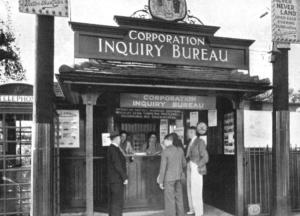
Corporation Inquiry Bureau
Work starting on removing the hill
Small remnants of more walls were also found
The ornate railings that once stood
along Pier Hill
The two small windows are from the Swimming Baths

Southend-on-Sea

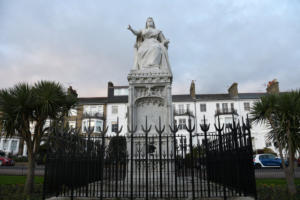

Website Info:

Southend-on-Sea’s No 1 History Website! Documenting The Town & The Townspeople
Now Incorporating The Sea Of Change Website


SOUTHEND CITY
Chalkwell ▪ Eastwood ▪ Leigh-on-Sea ▪ Prittlewell ▪ Shoeburyness ▪ Southchurch ▪ Thorpe Bay ▪ Westcliff-on-Sea
































































